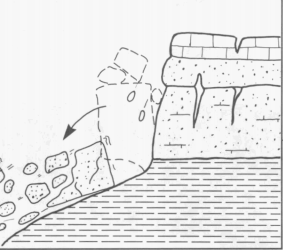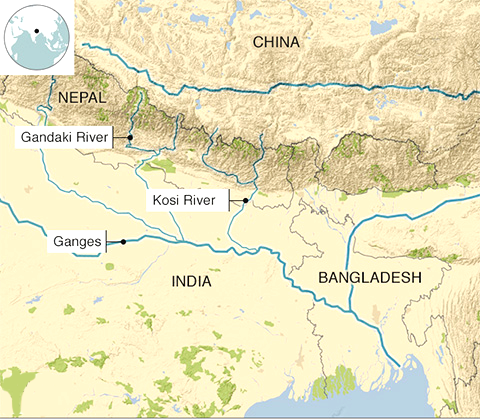Uttar Pradesh Switch to Hindi
Uttar Pradesh Government Defence Deals
Why in News?
Recently, the Uttar Pradesh government has signed more than 154 defence manufacturing deals worth Rs 25,000 crore.
Key Points
- According to the Ministry of Defence (MoD), India’s annual defence production is Rs 1.27 trillion in 2023-24 (FY24), which is 16.7% higher than 2023.
- The defence projects are coming up in the mega UP Defence Industrial Corridor (UPDIC) spanning six nodes of Lucknow, Kanpur, Jhansi, Aligarh, Chitrakoot and Agra districts.
- The Corridor’s nodal agency UP Expressway Industrial Development Authority (UPEIDA) has signed 154 Memorandums of Understanding (MoUs) with different companies such as Adani Defence and Aerospace, BrahMos Aerospace, Defence Research & Development Organisation (DRDO), etc.
- Uttar Pradesh is actively promoting defence manufacturing to drive its 'Make in UP' initiative.
- The state aims to leverage its extensive Micro, Small and Medium Enterprises (MSME) base to catalyze this effort
- A total of 35,000 Kalashnikov AK-203 assault rifles, assembled at the Korwa factory in Amethi district of Uttar Pradesh, have been given to the Indian Army by the Indo-Russia Rifles Private Limited joint venture.
- Another Indo-Russia joint venture plant is coming up in Lucknow to manufacture BrahMos missiles for the Indian defence forces.
- BrahMos is a joint venture between India’s Defence Research and Development Organisation (DRDO) and Russia’s NPOM (Non-Profit Organisation Mashinostroyeniya) to develop next-generation supersonic missiles for the Indian forces.
Uttar Pradesh Defence Industrial Corridor (UPDIC)
- It is an aspirational project that intends to reduce foreign dependence on the Indian Aerospace & Defence Sector. It was inaugurated in 2018.
- The Uttar Pradesh Expressways Industrial Development Authority (UPEIDA) was made the nodal agency to execute this project in conjunction with various other state agencies.
The Uttar Pradesh Expressways Industrial Development Authority (UPEIDA)
- It is an authority set up in 2007 by the Government of Uttar Pradesh to develop expressway projects in the state.
- The headquarters of UPEIDA is located at Paryatan Bhawan in Gomti Nagar, Lucknow.


Uttarakhand Switch to Hindi
Earthquake in Chamoli
Why in News?
Recently, an Earthquake hit the Chamoli region of Uttarakhand with its epicentre near the town of Joshimath.
Key Points
- According to the National Center for Seismology, the earthquake had a magnitude of 3.5 on the Richter scale and came amid heavy rainfall and landslides in the region.
Joshimath
- Joshimath is a hilly town located on the Rishikesh-Badrinath National Highway (NH-7) in Chamoli district of Uttarakhand.
- The city serves as a tourist town as it acts as an overnight rest stop for people visiting Badrinath, Auli, Valley of Flowers, and Hemkund Sahib, among other important religious and tourist locations in the state.
- Joshimath is also of great strategic importance to the Indian armed forces and is home to one of the Army's most important cantonments.
- The town (fall in high-risk seismic Zone-V) is traversed by running streams with a high gradient from Vishnuprayag, a confluence of the Dhauliganga and the Alaknanda rivers.


Uttarakhand Switch to Hindi
Char Dham Yatra Halted
Why in News?
- The Char Dham yatra has been temporarily halted for two days due to a heavy rain warning issued by the Regional Meteorological Centre.
Key Points
- Heavy rain has triggered landslides, blocking over 100 roads, including major National Highways.
Landslide
- A landslide is defined as the movement of a mass of rock, debris, or earth down a slope.
- They are a type of mass wasting, which denotes any downward movement of soil and rock under the direct influence of gravity.
- The term landslide encompasses five modes of slope movement: falls, topples, slides, spreads, and flows.
Char Dham Yatra
- Yamunotri Dham:
- Location: Uttarkashi district.
- Dedicated to: Goddess Yamuna.
- River Yamuna is the second-most sacred river in India after River Ganga.
- Gangotri Dham:
- Location: Uttarkashi district.
- Dedicated to: Goddess Ganga.
- Considered the most sacred of all Indian rivers.
- Kedarnath Dham:
- Location: Rudraprayag district.
- Dedicated to: Lord Shiva.
- Situated on the bank of the Mandakini River.
- One of the 12 Jyotirlingas (divine representations of Lord Shiva) in India.
- Badrinath Dham:
- Location: Chamoli district.
- Home to the sacred Badrinarayan Temple.
- Dedicated to: Lord Vishnu.
- One of the holy shrines for Vaishnavites.


Chhattisgarh Switch to Hindi
Chhattisgarh to Promote Local Languages in Schools
Why in News?
Recently, The Chhattisgarh government has decided to include local language and dialects in the primary education curriculum in order to ensure inclusive and quality education.
Key Points
- It is a big decision towards implementing National Education Policy (NEP) 2020 in tribal areas.
- Chhattisgarh Chief Minister Vishnu Deo Sai had directed the education department to develop and distribute bilingual books in 18 local languages and dialects, with focus on providing high-quality educational resources.
- A special emphasis has also been placed on vocational education, with plans to enhance skill development programmes in these areas.
- Local dialects include the Sadi language, which could be introduced for primary education in tribal-predominated Jashpur district.
- The three-language formula in NEP 2020 mandates that every student in India should learn three languages - two of which must be native Indian languages, including one regional language, and the third being English.
- It aims to strengthen national integration by exposing students to different cultures and languages while fostering respect for linguistic diversity.
- Shala Praveshotsav is celebrated in Raipur at the beginning of the new academic session to encourage children to enroll in schools.
- The state-level Shala Praveshotsav 2024 was inaugurated in Bagiya village of Jashpur, a remote tribal district of Chhattisgarh.
National Education Policy 2020
- The National Education Policy 2020 seeks to tackle the evolving development needs of India.
- It calls for a comprehensive overhaul of the education system, including its regulations and management, to establish a modern system that aligns with 21st-century educational goals, including Sustainable Development Goal 4 (SDG4), while respecting India's cultural heritage and values.
- It replaces the thirty-four year old National Policy on Education, 1986, modified in 1992 (NPE 1986/92).


Madhya Pradesh Switch to Hindi
Saplings Planting Drive in Madhya Pradesh
Why in News?
Recently, Madhya Pradesh Chief Minister Mohan Yadav launched the 'Ek Ped Maa Ke Naam' campaign under which 5.5 crore saplings will be planted in the state.
Key Points
- The CM started the campaign by planting an 'amla' sapling in the name of his late mother.
Tree Transplantation
- Tree Transplanting or replanting is the process of relocating a plant from one site to another in an agricultural field or garden.
- Tree transplants allow plants to have longer growing seasons.
- Plants can be cultivated indoors at first, then outside if the weather conditions are suitable.
- Tree spade machine is a specialized kind of machine that mechanizes the transplanting of large plants.
- Larger trees may require digging, wrapping or boxing of the root ball and then transporting by truck.
- In October 2020, the Delhi government approved a tree transplantation policy to prevent felling of trees due to development work in the city.
- Under the policy, agencies concerned have been asked to transplant 80% trees affected by the projects to a new location.
- Under this policy, 10 saplings are supposed to be planted in addition to the tree being dug up with the root intact and scientifically transplanted at another location instead of being felled.


Bihar Switch to Hindi
Workers Trapped in Floodwaters in Bihar
Why in News?
According to the sources, around 150 workers are trapped in floodwaters in Bagaha, Bihar due to heavy rainfall.
Key Points
- The State Disaster Response Force (SDRF) has rescued about 40 of the 150 stranded workers, including elderly, women, and children.
- According to the Water Resources Department, major rivers, including Kosi, Mahananda, Bagmati, Gandak, Kamla Balan, and Kamla, are above the danger mark.
Kosi River
- The Kosi is a trans-boundary river which flows through Tibet, Nepal and India.
- It has its source in Tibet that includes the world's highest upland, it then drains a large part of Nepal before emerging onto the Gangetic plains.
- Its three major tributaries, the Sun Kosi, Arun and Tamur meet at one point just upstream of a 10 km gorge cut through the Himalayan foothills.
- The river crosses into northern Bihar, where it branches into distributaries before joining the Ganges near Kursela in Katihar district.
- The Kosi carries the maximum amount of silt and sand after the Brahmaputra in India.
- It is also known as the “Sorrow of Bihar” as the annual floods affect about 21,000 sq. km. of fertile agricultural lands thereby disturbing the rural economy.
Mahananda River
- Mahananda river is a tributary of the Ganga.
- It originates from the Himalayas in Darjeeling, West Bengal.
- The river flows through Bihar, West Bengal, and then continues southeastward to join the Ganga at Godagari in Bangladesh.




.png)




.jpg)























.png)


.jpg)

 PCS Parikshan
PCS Parikshan





